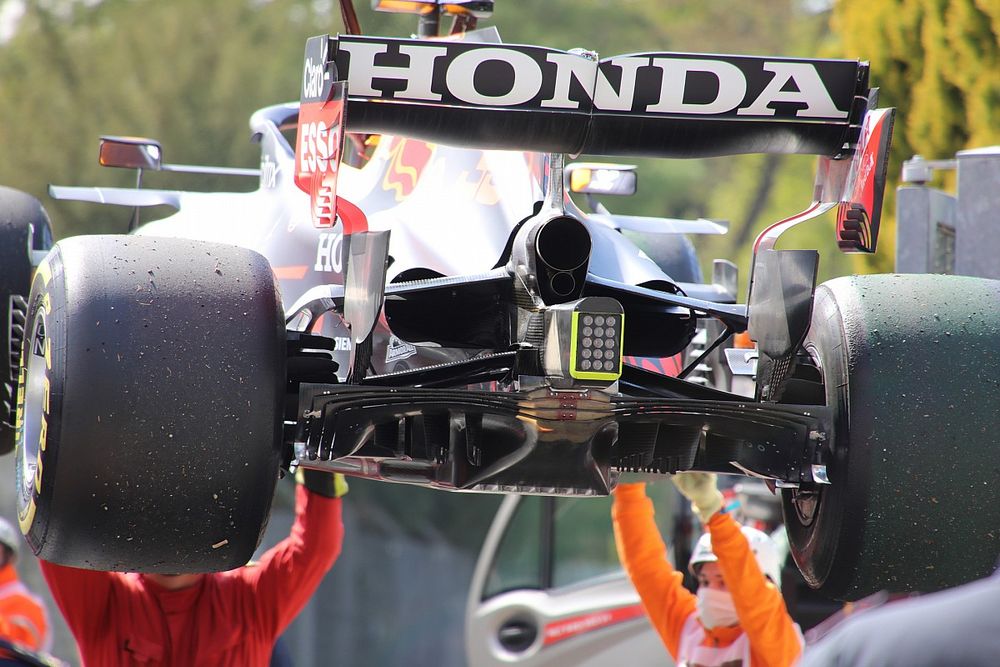What Verstappen's scenic tour revealed about Red Bull's secrets
Formula 1 teams go to great lengths to keep their design ideas secret from rivals, but sometimes events beyond their control end up revealing everything.

Last weekend, as Max Verstappen limped along the main straight with a broken driveshaft during Friday's second free practice session at Imola, little did he know that his Red Bull would end up on a magical mystery tour of the city as it was returned to the garage.
Having run over a kerb late in the lap, the car had hit trouble and, lacking drive, Verstappen stopped just beyond the pit exit.
However this left the car in a difficult place to recover. So a decision was made to load the car onto a flatbed truck and send it back to the Red Bull garage via the public roads that surround the circuit.
That trip wasn't exactly ideal for Red Bull.
Firstly the detour to get back to the paddock was a lengthy one, which meant there wasn't enough time for repairs to send Verstappen back out again.
But perhaps worse than that was the fact that the car was left fully exposed as it was loaded on to the truck, for the team's mechanics were not dispatched out to use the normal covers.
It wasn't lost on Red Bull motorsport advisor Helmut Marko about how some of the team's rivals would have loved to get a good look at the RB16B.
"The car only made it back to the paddock via a lot of detours. We thought it might go to Maranello," he quipped.
But while the car did not actually make it to Ferrari's factory, several photographers were at hand to get a close up look at the machine as it was hoisted off the ground and onto the recovery truck.
As Giorgio Piola's pictures show, this moment gave us a glimpse of a part of the car that's rarely visible, with the floor, its transition and the diffuser all on show.
Here then we look at what secrets were revealed as Verstappen's car was carried away.

Red Bull Racing RB16B rear detail
Photo by: Giorgio Piola
The close up shows how the team has continued to mount winglets on the lower half of the rear brake duct fence, albeit they're much narrower to comply with the new regulations.
Meanwhile, it's also worth noting how much effort the team has made to maintain the integrity of the diffuser's shape, with the rivets that hold the metal support on the other side of the three Gurney-like extensions visible and the lower section of the outermost extension given a metal finish.

Red Bull Racing RB16B floor detail
Photo by: Giorgio Piola
With the car on the recovery truck, Piola was also able to get closer to the car than has been the case of late, owing to the COVID protocols. He was able to snap this shot of one of the important areas of the car, given the latest regulation changes.
Red Bull is one of seven teams to be using the Z-Shaped floor cutout, with the team using an array of aerodynamic tricks ahead of it to help improve flow to the rear of the car.
The five fins and the large strake (white arrows) are all angled out toward the edge of the floor to help coerce the airflow's direction as it passes down the length of the car and entwine the flow structure that they create with the one created by the floor cutout.

Red Bull Racing RB16B rear wheel detail
Photo by: Giorgio Piola
The red flag period during the race also provided Piola with an opportunity to capture further images that reveal some of the car's design secrets, with this shot of the rear end without the wheel mounted affording us the opportunity to look at the rear brake duct, the design of the floor strakes mounted ahead and the edge of the diffuser.
You'll note how the team has enlarged the aperture in the upright during their redesign of the rear suspension during the winter, plus how various outlets are present in the brake drum in order to release the heat generated by the brakes into the void between it and the wheel rim.
These outlets are placed about the drum so heat can be radiated into the wheel and as a consequence the tyre in a specific way. This is in order to control the bulk temperature of the tyre and improve performance and reduce wear.
The edge of the floor and primary outboard strake are also one surface, rolled up in a very specific way in order to induce the flow structure that's desired, with a deliberate but subtle upswept section at the rear of the floor (red arrow).
The innermost Gurney-like diffuser extension also reaches forward to help encourage an interaction and enforce the work being done on the edge of the diffuser's wall (blue arrow).
Be part of the Autosport community
Join the conversationShare Or Save This Story
Related video
Subscribe and access Autosport.com with your ad-blocker.
From Formula 1 to MotoGP we report straight from the paddock because we love our sport, just like you. In order to keep delivering our expert journalism, our website uses advertising. Still, we want to give you the opportunity to enjoy an ad-free and tracker-free website and to continue using your adblocker.



















Top Comments